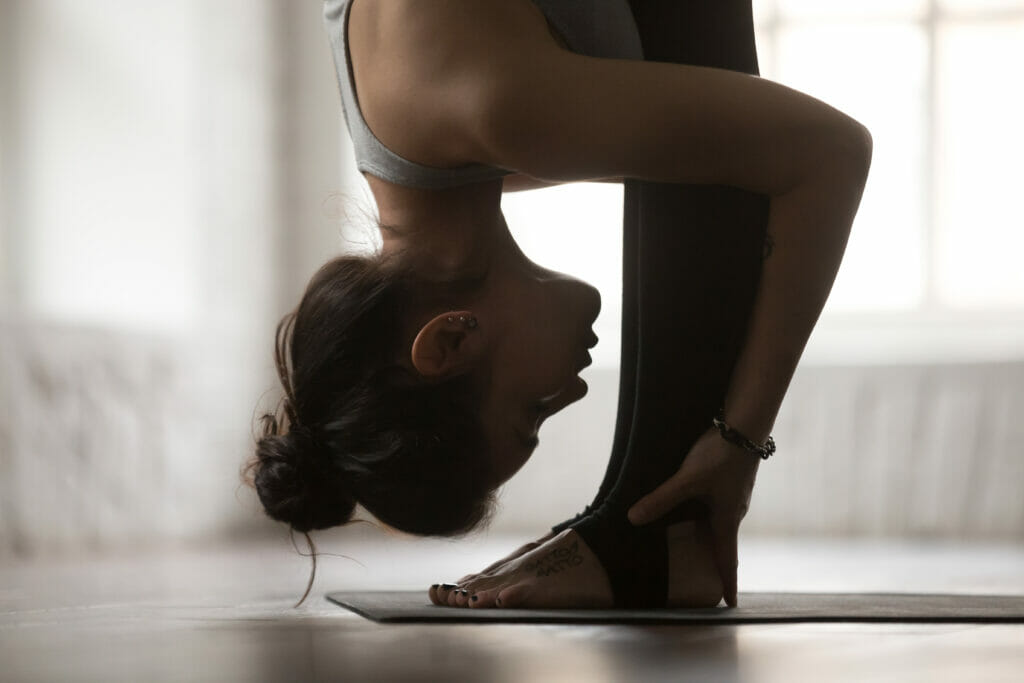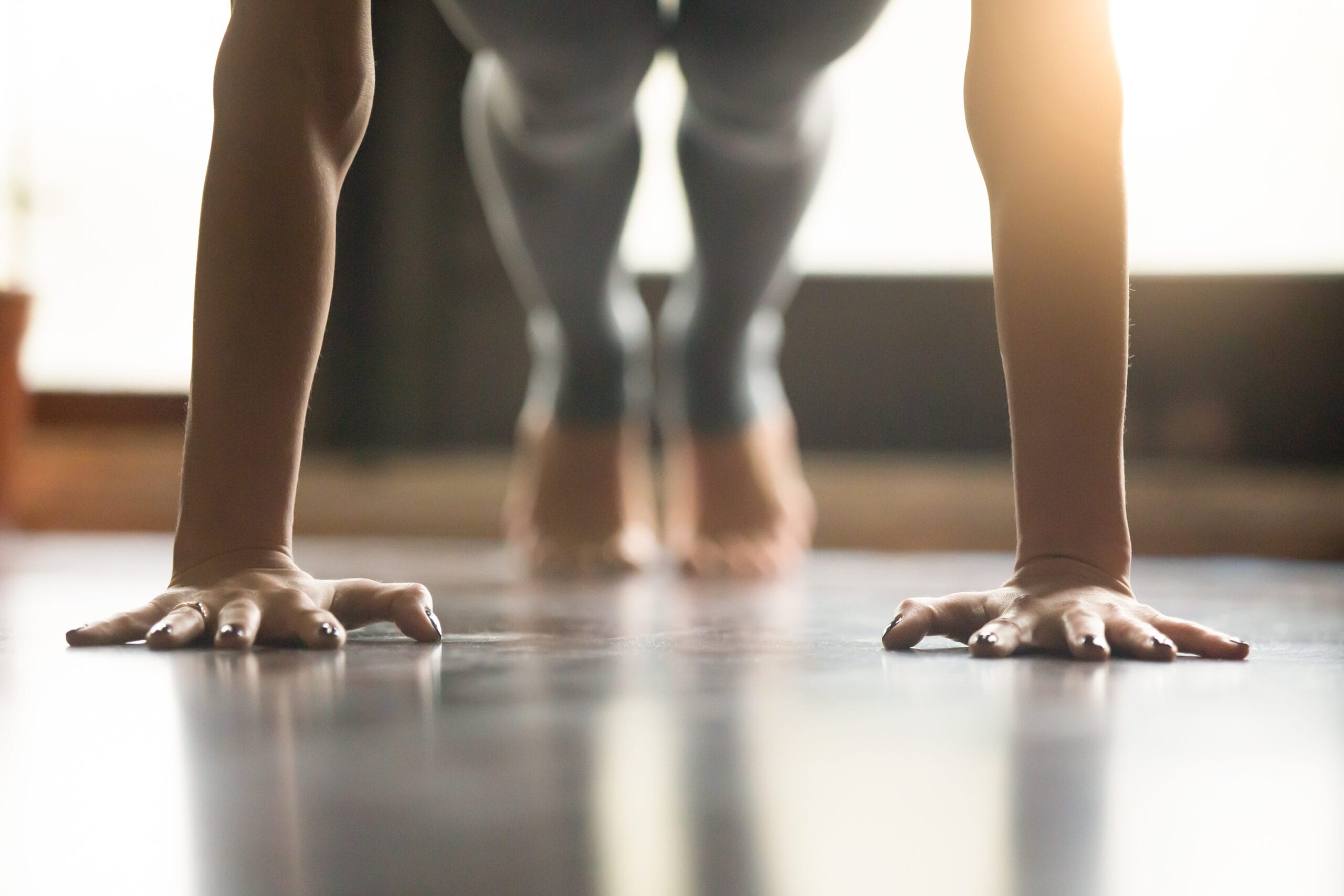
Yoga can be great for stretching and strengthening pretty much every muscle in your body, but it’s also awesome because you don’t need any expensive equipment to do it.
Most poses only require a comfortable mat and a little floor space, making it very conducive to performing from home.
And when it comes to dealing with low back pain, yoga can be exceptionally beneficial – in fact, a lot of the stretches physical therapists use to treat generalized low back pain come from various yoga poses.
That said, if you’re dealing with back pain, you can’t expect to just start doing random yoga exercises and expect your pain to magically disappear.
Nope, it’s a good idea to have a game plan to make sure you’re targeting the right exercises (and muscles) to get the most from your effort.
And that’s where I can help.
In this article, I’ll go over the top yoga exercises we can do from home to help combat generalized low back pain (and don’t worry, you don’t have to be a seasoned yogi to do these moves).
After reading, you’ll be ready to start implementing these exercises right away to help control your back discomfort.
Yoga & Back Pain
Full disclosure, I don’t have a lot of experience with yoga.
I’ve taken a few classes in the past, but the most exposure I got to it was back in the days when I was doing P90X.
If you’re not familiar with P90X, I don’t blame ya, it’s pretty old these days. But basically, it was a workout and nutrition plan aimed to help get ya in great shape in 90 days.
I ordered the system like 15 years ago and did it off and on several times over the years and got some great results from it.
Anyway, one of the workouts was a yoga routine and I was surprised by how challenging it was.
Not only was it like 90 minutes long, but it was brutal holding and moving through a lot of these different poses.
Now that yoga routine was gear around strengthening, so it included moving through series of poses that required holding a lot of lunges and squat positions for extended periods.
But there are a lot of moves in yoga and they don’t all require this.
As I started getting acquainted with yoga, I noticed there were a lot of poses that looked familiar to me – not because I had done much yoga before, but because I’m a physical therapist.
I soon realized that a lot of the stretches I was teaching my patients came from yoga (I might’ve been calling ’em something different, but the moves themselves were identical).
What I’ve learned from my limited experience is that yoga includes a lot of stretching and static holding of poses, both of which are great ways to treat generalized back pain.
And when I say “generalized” back pain, I’m not talking about pain coming from a specific diagnosable disorder (like a herniated disc or pinched nerve).
No, this is more the achy pain that comes and goes and doesn’t have a cause that’ll show up on an x-ray or MRI.
This is the kind of stuff therapists treat all the time and I can tell you more times than not that it comes from a combination of tight muscles and weak muscles.
In other words, muscle imbalances.
Most of us have poor posture or spend too much time sitting down in front of a computer (guilty) and this causes some muscles to become tight (hip flexors, hamstrings) and others to get weak (core stabilizers, glutes, etc).
And when this imbalance happens, it’s just a matter of time until stuff starts hurting.
Low back pain is super common and although I don’t have any numbers to back this statement up, I’d wager it’s the most common non-life threatening ailment out there.
Anyway, treating these muscle imbalances means stretching the tight muscles and strengthening up the weak ones and guess what just so happens to combine these 2 exercise principles into a single system….yoga.
And since most poses are held statically and can be modified, these exercises should be safe for most folks to do, regardless of age.
That said, you shouldn’t feel any increased pain while doing any of these exercises – if you do, please discontinue immediately because you could be doing more harm than good.
And as always, if you’re unsure about any exercise listed below, please consult your physician or physical therapist before attempting (it’s always better to be safe than sorry).
The 6 Best Yoga Exercises For Low Back Pain
#1. Cat-Cow
This is a classic therapy exercise that comes directly from yoga and even though it’s used a lot to treat thoracic and cervical issues, it’s a good move for low back issues too.
This pose gets the entire spine moving gently into flexion and extension and avoids rotation, which can be challenging for aging spines.
This is a great exercise for all of us, regardless of whether we’re having back pain or not and it works well as a warm-up before starting a workout.
I like to do 10 reps (up and down is 1 rep), but you can adjust based on how it feels.
And if you have discomfort with either end range, simply cut the movement short to make sure you stay within a pain free range.
#2 Downward Facing Dog
This is probably the most well-known yoga pose and I’d bet a lot of folks who have never done yoga before still have an idea of what this exercise is.
From a low back pain perspective, this exercise is great for a couple of reasons.
First, it’s a great way to stretch your hamstrings, which when tight, can lead directly to back pain.
It also stretches out your low back and encages your core stabilizers as well, not to mention working your shoulders at the same time.
Depending on your hamstring mobility, you might have to bend your knees during this exercise and that’s ok.
And for beginners, don’t worry about bringing your heels off the floor.
Don’t be surprised if you find this pose challenging because it is – there are a lot of muscles engaging and elongating during this stretch so take your time and modify as needed.
You can hold for 5 breaths or aim for time (20 – 30 sec).
#3 Supine Spinal Twist
This is another great back exercise because it stretches a lot of different low back muscles, but it also stretches the glutes and piriformis muscles in the posterior hips.
And I love that it involves rotation, a movement a lot of us probably don’t get enough of during our daily routines.
This is another great move for all of us, but it can be especially helpful for folks with achy backs or sciatica.
You can modify this move by keeping both knees together and holding for less time (something we call a lateral trunk rotation or ‘LTR’ in therapy), but personally, you’ll get a better stretch doing the full spinal twist to each side individually.
Holding for 30 seconds is a good place to start and you can do multiple reps per side, depending on how it feels.
#4 Triangle Pose
Triangle pose is one I learned from my P90X days and I can tell you it’s a lot harder than the pros make it look.
If you’re as tight as me, you’re gonna really feel this in your hamstrings, but it also stretches out your adductors (inner thigh muscles) too.
And since it includes spinal rotation, it helps open up a lot of stuff around your core.
When working on this stretch, pay attention to your foot position and trying to keep things straight like the instructor above mentions.
And don’t be ashamed if you can’t reach the ground – it’ll get better with time.
20-30 seconds per side is a good place to start with this pose.
#5 Sitting Half Spinal Twist
This is another twisting exercise and like the supine version mentioned above, it too stretches a lot of stuff at the same time.
I especially like this move because you can do it sitting, so you don’t have to get all the way to ground, and because it really stretches the posterior hip muscles.
And I can tell ya, if you’re having back pain, you need to be stretching your glutes and piriformis muscles.
This exercise is awesome for folks dealing with thoracic and cervical discomfort too.
I do this exercise on a regular basis and it works wonders after a long writing session.
I like to hold this one for about 20-30 seconds per side, focusing on deep breaths in and out (and trying to stretch a little farther with each exhale).
#6 Cobra Pose
Cobra is a good one because it focuses on extension – and everything we do in life is so geared toward flexion.
As we sit watching tv or working on the computer, it’s almost impossible not to adopt a forward head, rounded shoulder, rounded lumbar spine posture.
And with time, all the muscles in these positions (flexors) get tight, making it hard to straighten out again.
Well, cobra is a pretty safe way to start stretching out these tight flexors and strengthening up the weak extensors.
This stretch can help lengthen the hip flexors, which is important for back pain, but it can also help stretch out tight pecs and cervical flexors too.
And the isometric hold of the glutes and spinal extensors is a gentle way to get a little strengthening in at the same time.
Oh, and if you are dealing with a pinched nerve or bulging disc, spinal extension can be helpful.
Final Thoughts
There are a ton of other yoga poses that I’m sure would be helpful for back health as well, but I really like the above exercises because they’re relatively easy to do correctly and they’re fairly safe for most folks to do without expert supervision.
The key to these moves is all about safety and not pushing yourself past your limits and never ignoring pain.
If you feel increased pain while doing any of these exercises, please stop – these stretches should not increase pain!
Some discomfort from stretching tight muscles is normal, but not pain.
Alrighty, that’ll do it for me.
I hope you found this helpful and if you know any great yoga stretches for back pain that I missed, please share.
Just leave a comment below and I’ll get back to you shortly.


